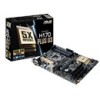Asus H170-PLUS D3 User Guide - Page 57
CPU Graphics Power Duty Control [T.Probe]
 |
View all Asus H170-PLUS D3 manuals
Add to My Manuals
Save this manual to your list of manuals |
Page 57 highlights
CPU Current Capability [Auto] Allows you to configure the total power range, and extends the overclocking frequency range simultaneously. Configuration options: [Auto] [100%] [110%] [120%] [130%] [140%] Choose a higher value when overclocking, or under a high CPU loading for extra power support. CPU Graphics Load-Line Calibration [Auto] Load-line is defined by Intel VRM specification and affects GT power voltage. The GT working voltage will decrease proportionally to GT loading. Higher levels of the load-line calibration can get a higher voltage and better overclocking performance, but increases the GT and VRM thermal conditions. Select from level 1 to 8 to adjust the GT power voltage from 0% to 100%. The actual performance boost may vary depending on the GT specification. Do not remove the thermal module. CPU Graphics Current Capability [Auto] This item allows you to adjust the total power range for GT overclocking. A higher value provides a wider total power range and extends the overclocking frequency range simultaneously. Configuration options: [Auto] [100%] [110%] [120%] [130%] [140%] Choose a higher value when overclocking, or under a high GT loading for extra power support. CPU Graphics Switching Frequency [Auto] This item affects the GT transient response speed and the component thermal production. Select [Manual] to configure a higher frequency for a quicker transient response speed. Configuration options: [Auto] [Manual] DO NOT remove the thermal module. The thermal conditions should be monitored. The following items appear only when you set the GT Switching Frequency to [Manual]. CPU Graphics Power Duty Control [T.Probe] DIGI+ VRM Duty Control adjusts the current and thermal conditions of every component's phase. [T.Probe] Select to maintain the VRM thermal balance. [Extreme] Select to maintain the current VRM balance. ASUS H170-PLUS D3 2-23















